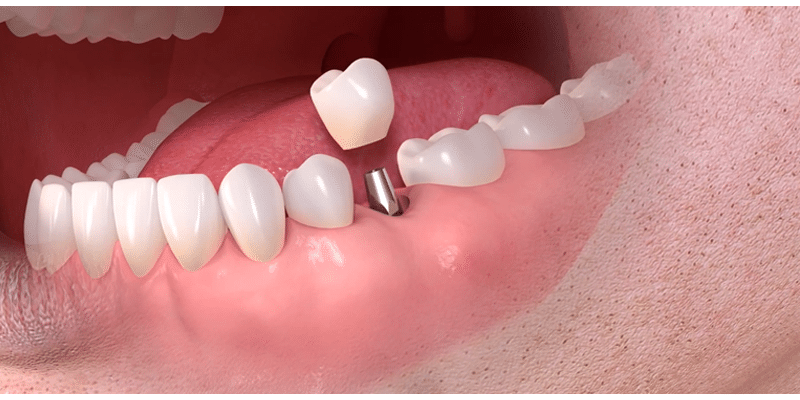Dental Bridge Treatment
Dental Bridge Treatment Client’s want to know “Dental Bridge Vs Implant”. Many methods and appliances are used as treatments to restore missing teeth. The most well-known and widely used implant treatment is dental bridge prostheses. In the case of tooth loss, adverse conditions such as affecting all teeth, discontinuities, upper and lower dental arches. Early contact, periodontal problems, and caries occur. Therefore, in the replacement process of missing teeth, the functional, pronunciation. And aesthetic reconstruction of missing teeth and the continuity of the dental arch are required. The main indication for bridge restorations is to prevent the degradation of the entire system and protect the teeth in this way. A restoration that completes the edentulous position in the oral cavity. And transmits the masticatory pressure to the jawbone by supporting the teeth and mucosa is called a “fixed restoration treatment process”.
A bridge treatment process is a type of fixed prosthesis that consists of a retainer crown for natural teeth. And a body that is placed in the place of the missing tooth and attached to these retainer crowns. Simply put, if there are multiple crowns made of a fixed prosthesis, it is called a bridge. The characteristic difference between a bridge. And a crown is that it carries the masticatory pressure from the missing tooth on the bridge. In other words, when a tooth is crowned, the pressure on it remains the same. But at the bridge, this situation can increase significantly compared to the number of missing teeth. The pressure on the crown prosthesis is natural, but the pressure on the bridge is somewhat pathological. The support for making a crown is the tooth itself. However, the bridge treatment process support is a cut tooth that exerts mesial.
Dental Implant Treatment Process
This is the name of the titanium screw used to remove missing teeth. These screws act as roots and by applying permanent restorations of different shapes, patients get new teeth. It is a long-lasting application treatment process that can replace natural teeth both functionally and aesthetically. First, the inspection phase takes place. At this stage, the bone thickness, bone height, other structures in the jaw, and the neighborhood of the implanted area are assessed by various X-rays or tomography. In short, to determine whether the bone structure is suitable for treatment. Once the controls are complete, the implementation phase begins. Implants treatment process made of titanium material, are placed in open cavities in the bone in a sterile environment using medical devices.
The placed implant treatment process functions as a root and must be fused to the bone, the duration of which fusion varies between 2-3 months. While waiting for this period, the implant treatment process will not remain empty. It is close with a temporary prosthesis to the extent that the patient’s dental relationship allows. After waiting for the fusion of the bone and implant treatment process surface, take another X-ray under the supervision of a doctor to check the situation. If the fusion is successful, open the gingiva slightly, prepare the tissue around the implant treatment process, and place a practice prosthesis to help the patient understand the prosthesis in advance. After a 7-day acclimatization period, if there is no retreat, the mouth will be in a position to lift the prosthesis. In this case, the fix denture is make as the last step.
Advantages and Disadvantages of Bridges Treatment Process
Dental bridges provide you with the right smile at an affordable price compare to implants. It’s functional, reliable, and predictable. The bridge may be partially covere by some dental insurance and most insurance plans do not cover implants. Also, since only minimally invasive dental treatment is require, no recovery time is require and complete treatment is shorter than implants. Disadvantages; If there is an existing crown on the adjacent tooth, the crown will have to accommodate the bridge. In addition, if the nerves in the teeth are affect by the procedure. They are more likely to develop periodontal disease or require root canal treatment. Regular maintenance of the bridge is slightly more important than implants treatment process. Special equipment is require to remove plaque. Finally, bridges don’t last as long as implants treatment process. These will need to be replace later.
Advantages and Disadvantages of Implants
Implants are as functional, predictable, and reliable as bridges. Aesthetically, they resemble your natural teeth and will feel like your natural teeth when they are place on your jaw. Implants do not effect adjacent teeth, so the risk of tooth decay and periodontal disease is not high. Implants are no different from your natural teeth. It is very successful with a success rate of over 98%. Implants can be do on the same day for patients who meet certain criteria.
Dental Bridge Vs Implant Treatment Process
Implants are much closer to natural teeth than bridges in that they perform masticatory and speech functions and an aesthetic appearance. One of the drawbacks of bridges is the risk that the teeth use as bridge abutments will collapse over time. In this case, the collapse tooth needs to be treat and the bridge renew. Implants do not have such a risk. Bridges are also more likely to develop periodontal disease than implants. The only important advantage of the bridge is its low price. But give the safer, the implants are more profitable in the long run. The fact that the bridge is easy to build can be see as an advantage, but give the positive aspects of the implant in the big picture, this remains a negligible detail.
Other situations in which a bridge treatment process may take precedence are; If there is a problem with adjacent teeth. It is broke, has restorations, or contains large padding, and if they are cover and healthier. Then the bridge treatment process may be consider the first choice. Dental bridge treatment process vs implant treatment process. Dental implants treatment process may not fit. Implant transplantation treatment process is not perform on children. Or individuals who have not completed bone development.
How Long is Breast Augmentation Surgery for Healthy Patients?
While breast augmentation surgery itself is relatively quick, the answer “how long is breast augmentation surgery?” in the operating room will depend on a few factors. The actual duration of breast augmentation surgery for healthy patients typically ranges from one to two hours. During this time, the surgeon will make an incision, insert the implants, and position them to achieve the desired results. In some cases, the surgery may take slightly longer if additional techniques are used to create a better contour or to address certain health concerns. The total time spent in the operating room will also be affected by the type of anesthesia used during the surgery.
 Additionally, some surgeons may spend more time than others in positioning and adjusting the implants to ensure they look as natural as possible. In most cases, the entire process from check-in to discharge takes about three to four hours. This includes pre-surgery preparation, surgery time, recovery time in the recovery room, and post-op instructions. Patients should plan on having someone available to drive them home and stay with them for the first 24 hours after surgery due to potential side effects from anesthesia. This should answer the question “how long is breast augmentation surgery for healthy patients?”
Additionally, some surgeons may spend more time than others in positioning and adjusting the implants to ensure they look as natural as possible. In most cases, the entire process from check-in to discharge takes about three to four hours. This includes pre-surgery preparation, surgery time, recovery time in the recovery room, and post-op instructions. Patients should plan on having someone available to drive them home and stay with them for the first 24 hours after surgery due to potential side effects from anesthesia. This should answer the question “how long is breast augmentation surgery for healthy patients?”



